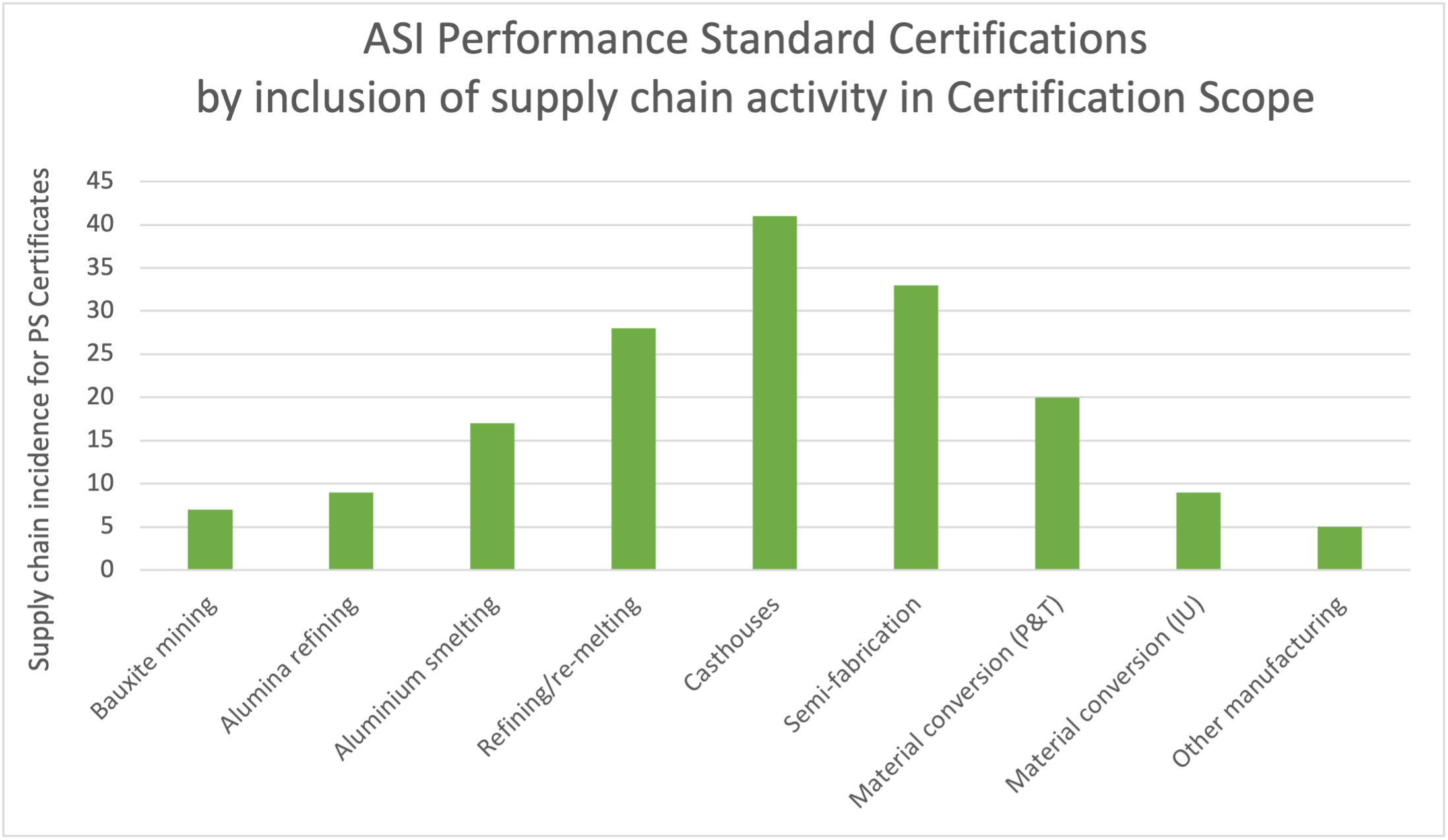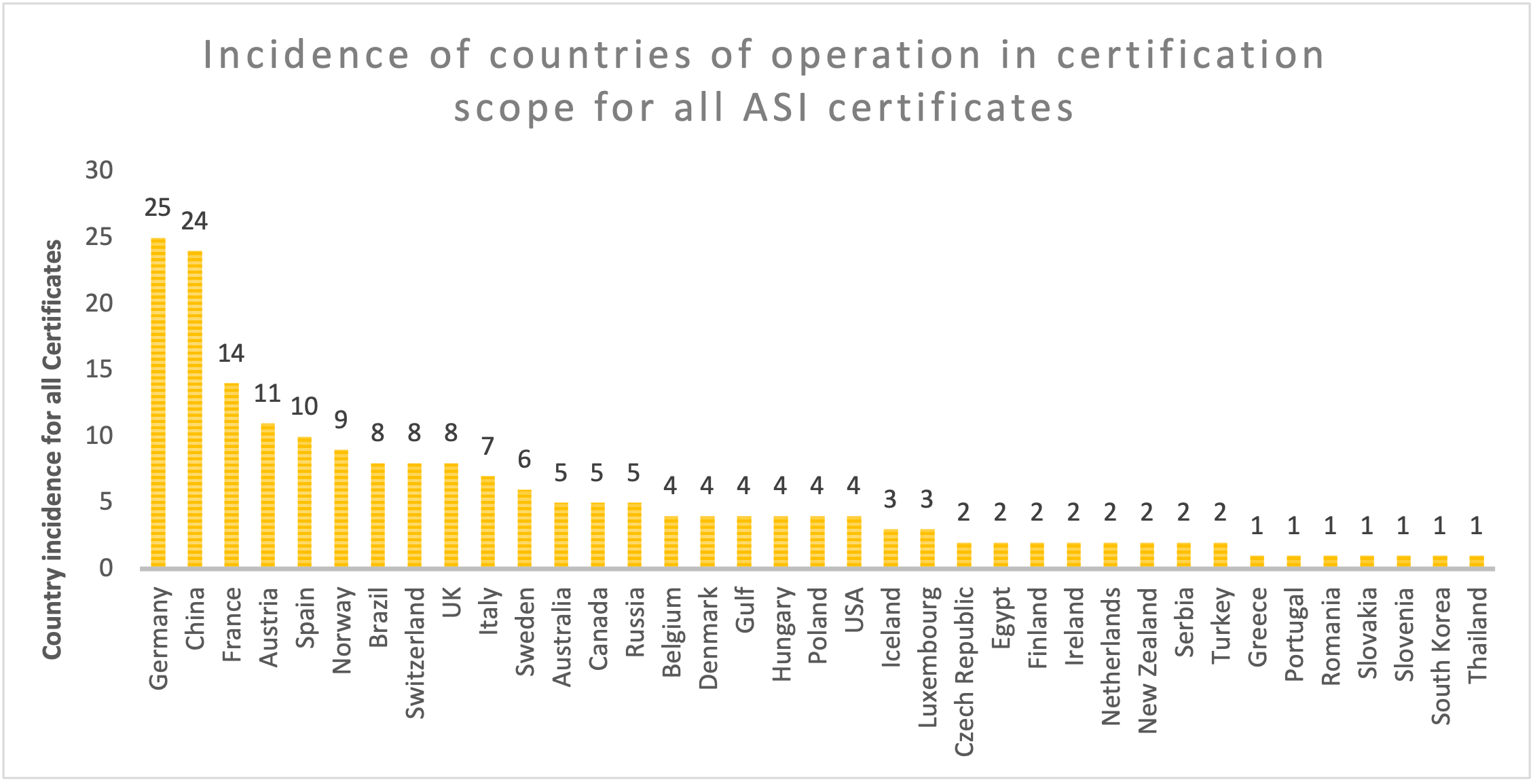Evidence of growing ASI Certification uptake along the aluminium value chain
M&E Insights, February 2021 ASI designed its certification program to foster responsible production, sourcing and stewardship of aluminium along the value chain. Strong uptake of ASI Certification by diverse business is an important step to meeting our Theory of Change. Three years since the launch of the ASI Certification program in December 2017, how are […]
23 February 2021
 M&E Insights, February 2021
M&E Insights, February 2021
ASI designed its certification program to foster responsible production, sourcing and stewardship of aluminium along the value chain. Strong uptake of ASI Certification by diverse business is an important step to meeting our Theory of Change. Three years since the launch of the ASI Certification program in December 2017, how are we doing on this indicator?
ASI Certifications by Standard, per year
In the first three years of the ASI Certification program, ASI issued a total of 105 Certifications against the Performance Standard (74) and Chain of Custody (CoC) Standard (31), from 1 January 2018 to 31 December 2020.
 So far, most Performance Standard certifications took place in 2019. This reflects the pool of pre-2017 ASI members that needed to achieve their membership commitment to achieve at least one ASI Certification within two years of the launch of the program. The COVID-19 pandemic in 2020 resulted in some planned audits being postponed due to national lockdowns and travel restrictions. ASI implemented an interim audit policy to enable remote auditing in for these circumstances, with on-site audits to take place when they are again possible.
So far, most Performance Standard certifications took place in 2019. This reflects the pool of pre-2017 ASI members that needed to achieve their membership commitment to achieve at least one ASI Certification within two years of the launch of the program. The COVID-19 pandemic in 2020 resulted in some planned audits being postponed due to national lockdowns and travel restrictions. ASI implemented an interim audit policy to enable remote auditing in for these circumstances, with on-site audits to take place when they are again possible.
The number of Chain of Custody (CoC) Certifications increased by 55% in 2020 (17) over number achieved in 2019 (11). After Performance Standard Certifications are achieved, ASI members often turn their attention to then achieving CoC Certification. CoC audits can also be undertaken as a remote/desktop exercise during the COVID-19 pandemic, so audits do not need to be postponed.
Despite the challenging global situation in 2020, the ongoing uptake of ASI Certification during that year is a good indication of the commitment of ASI members to the program. During 2020, an additional 33 new ASI members joined in the Production and Transformation and Industrial Users membership classes, making their own commitment to ASI Certification in the next two years.
ASI Certifications – Performance Standard – by supply chain activity
The first chart shows the uptake of the ASI Performance Standard to 31 December 2020 along the aluminium value chain by supply chain activity as defined in the ASI Standard. It shows that ASI Certifications addressing responsible practices are in place through each step of the aluminium value chain. Casthouses, Semi-fabrication and Refining/Re-melting of aluminium have the highest incidence so far, which aligns with their central role connecting upstream production with downstream applications and shows the importance of aluminium recycling.
 Casthouses: 41 ASI Certifications for the Performance Standard include one or more Casthouses in their Certification Scope, making it the most common supply chain activity. The Casthouse is where liquid primary or recycled metal is cast into standardised shapes and/or alloys, making it the starting point for further semi-fabrication of aluminium and subsequent downstream manufacturing.
Casthouses: 41 ASI Certifications for the Performance Standard include one or more Casthouses in their Certification Scope, making it the most common supply chain activity. The Casthouse is where liquid primary or recycled metal is cast into standardised shapes and/or alloys, making it the starting point for further semi-fabrication of aluminium and subsequent downstream manufacturing.- Semi-fabrication: 33 ASI Certifications for the Performance Standard include one or more Semi-Fabrication process, making it the second most common supply chain activity. Semi-Fabrication includes rolling and extrusion of casthouse products before subsequent downstream manufacturing.
- Bauxite Mining: 7 ASI Certifications for the Performance Standard include Bauxite Mining in their Certification Scope, covering a total of 11 mines in Australia, Brazil and Russia.
- Alumina Refining: 9 ASI Certifications for the Performance Standard include Alumina Refining in their Certification Scope.
- Aluminium Smelting: 17 ASI Certifications for the Performance Standard include Aluminium Smelting in their Certification Scope.
- Refining/re-melting: 28 ASI Certifications for the Performance Standard include Refining/re-melting in their Certification Scope.
- Downstream: 20 ASI Certifications for the Performance Standard include Material Conversion (Production & Transformation) in their Certification Scope, 9 ASI Certifications for the Performance Standard include Material Conversion (Industrial Users) in their Certification Scope, and 5 ASI Certifications include Other Manufacturing or sale of products containing Aluminium in their Certification Scope.
ASI Certifications – Chain of Custody Standard – by supply chain activity
The second chart shows the uptake of the ASI Chain of Custody Standard to 31 December 2020 by supply chain activity as defined in the ASI Standard. It also shows that ASI Certifications addressing chain of custody systems are in place through each step of the aluminium value chain. ‘Post-Casthouse’ supply chain activities have the highest incidence so far, which suggests there is growing commitment from downstream aluminium users that wish to make responsible sourcing claims. This includes interest in on-product claims, particularly in packaging.
 Post-Casthouse: ‘Post-Casthouse’ includes the Semi-Fabrication stages onwards. For CoC Certifications, 25 include one or more Post-Casthouse activities in their Certification Scope. This suggests there is growing commitment from downstream aluminium users that wish to make responsible sourcing claims. This includes interest in on-product claims, particularly in packaging.
Post-Casthouse: ‘Post-Casthouse’ includes the Semi-Fabrication stages onwards. For CoC Certifications, 25 include one or more Post-Casthouse activities in their Certification Scope. This suggests there is growing commitment from downstream aluminium users that wish to make responsible sourcing claims. This includes interest in on-product claims, particularly in packaging.- Primary aluminium: There are 5 ASI CoC Certifications that include Bauxite Mining, 6 that include Aluminium Refining and 7 that include Aluminium Smelting in their Certification Scope.
Secondary aluminium: There are 15 ASI CoC Certifications that include Aluminium Refining/Re-melting in their Certification Scope, demonstrating the importance of a circular economy approach in the ASI Standards.
ASI Certifications issued by sector
Aluminium is used in a very wide range of sectors such as transport, construction, packaging, electricity and heating, machinery and equipment, consumer goods and many others. This data is collected through analysing ASI Public Summary Audit reports and ASI press releases, and a level of judgement has been used to allocate ASI Certifications to the nominated sectors. Each ASI Certification will have one or more ‘sector connections’. The data shows that connections to the packaging sector has the most incidence in ASI Certifications to date.
 Number and Identity of countries
Number and Identity of countries
The final chart below shows that after only three years of implementation of our program, ASI Certifications can already be found in 40 countries in every continent around the world. Most Certifications are located in Germany (15 for the Performance Standard and 10 Chain of Custody), closely followed by China (14 for the Performance Standard and 10 Chain of Custody), and then France (9 for the Performance Standard and 5 Chain of Custody). There are also ASI Certifications in other important primary production countries such as Brazil, the Gulf region (Bahrain, Saudi Arabia and UAE), Russia, Canada and Australia.
 Visit the ASI Certifications Map to find out where all ASI Performance Standard and Chain of Custody Certified Entities are located.
Visit the ASI Certifications Map to find out where all ASI Performance Standard and Chain of Custody Certified Entities are located.
SHARE THIS ARTICLE


